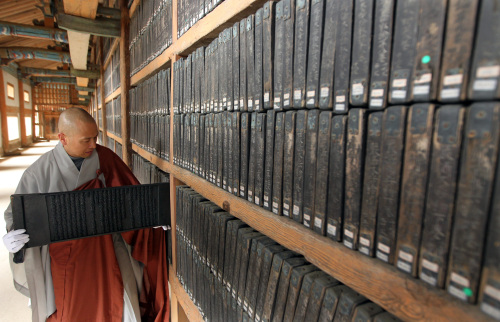Hapcheon hosts 45-day festival of exhibitions, activities, art and an academic forum
Deep inside the folds of Mount Gaya in South Gyeongsang Province, Haein Temple houses the world’s most comprehensive and oldest intact Buddhist canon, the Tripitaka Koreana.
Haein Temple in Hapcheon County kicks off a 45-day festival Friday to celebrate the 1,000th year of the creation of the “Chojo Daejanggyeong,” the first edition of the Tripitaka Koreana, in 1011 during the Goryeo Kingdom era (935-1390).
The leaders of Goryeo sought to protect the kingdom from the Mongol invasion through Buddha’s power.
The tripitaka was inscribed in UNESCO’s Memory of the World in 2007 and its depository, Janggyeong Panjeon, was designated a UNESCO World Heritage site in 1995.
The festival, “Millennial Anniversary of the Tripitaka Koreana, 2011,” will focus on shedding light on the value and historical significance of the Tripitaka Koreana, as well as promoting it to the outside world through various experience events, an art event and an international academic forum, the organizers said.
Deep inside the folds of Mount Gaya in South Gyeongsang Province, Haein Temple houses the world’s most comprehensive and oldest intact Buddhist canon, the Tripitaka Koreana.
Haein Temple in Hapcheon County kicks off a 45-day festival Friday to celebrate the 1,000th year of the creation of the “Chojo Daejanggyeong,” the first edition of the Tripitaka Koreana, in 1011 during the Goryeo Kingdom era (935-1390).
The leaders of Goryeo sought to protect the kingdom from the Mongol invasion through Buddha’s power.
The tripitaka was inscribed in UNESCO’s Memory of the World in 2007 and its depository, Janggyeong Panjeon, was designated a UNESCO World Heritage site in 1995.
The festival, “Millennial Anniversary of the Tripitaka Koreana, 2011,” will focus on shedding light on the value and historical significance of the Tripitaka Koreana, as well as promoting it to the outside world through various experience events, an art event and an international academic forum, the organizers said.

Prime Minister Kim Hwang-sik, South Gyeongsang Province Governor Kim Du-kwan, Ven. Beopjeon of the Jogye Order and Culture Minister Choe Kwang-sik, as well as 32 ambassadors and their spouses from 17 countries will attend the opening ceremony on Friday afternoon at the Main Event Hall in Gaya-myeon in Hapcheon, under the title “Forest of wisdom.”
The festival takes place in the Main Event Hall, as well as in Haein Temple and Changwon Exhibition Convention Center.
At the Main Event Hall, there will be five major exhibitions: Explaining the Tripitaka Koreana; 1000 years of documenting history through media art performances; explaining Buddhist wisdom carved on the tripitaka; woodcut and print works by international artists from 60 countries; and inviting visitors to participate in writing messages to future generations 1,000 years later in 3011.
One of the highlights will be the exhibition of two wooden printing blocks of the Tripikana Koreana that have been temporarily moved from the Janggyeong Panjeon. The depository is still strictly off limits to the public.
Haein Temple’s Seonwon, the training space for monks, will be open to the public on Friday for the first time in 1,200 years but it will be open only for one day.
Experience programs will take place at the Floor of the Millennium. Programs include engraving wood blocks, creating a miniature of Janggyeong Panjeon, making a lantern, learning Buddhist tea drinking etiquette and making millennial wishes. Visitors will be also encouraged to participate in the millennial treasure hunt.
On Sept. 28-29, the organizers will host an academic forum, “Millennial Goryeo Daejanggyeong Communicates with the World,” at the Convention Hall of CECO in Changwon. Participants will discuss how to promote the Tripitaka Korea to the world and suggestions for utilizing it.
As a side event, the “Haein Art Project” will showcase paintings, sculptures and video works by 30 international artists at the Haein Temple and 13 nearby small temples.
The closing ceremony will be held on Nov. 6 at 5 p.m. at the Borisu Concert Hall where a time capsule, containing a millennial wish and details on how the festival went, will be sealed.
Sori Path, a 6 km-long valley road between the main event venue and the temple, will provide the pleasing sounds of flowing water.
The organizers said about 1.5 million visitors including 80,000 foreign tourists are expected to participate in the festival.
Admission rates are 10,000 won for adults, 8,000 won for teenagers and 6,000 won for children under 12. For more information, visit www.tripitaka2011.com.
By Kim Yoon-mi (yoonmi@heraldcorp.com)







![[KH Explains] How should Korea adjust its trade defenses against Chinese EVs?](http://res.heraldm.com/phpwas/restmb_idxmake.php?idx=644&simg=/content/image/2024/04/15/20240415050562_0.jpg&u=20240415144419)











![[Today’s K-pop] Stray Kids to return soon: report](http://res.heraldm.com/phpwas/restmb_idxmake.php?idx=642&simg=/content/image/2024/04/16/20240416050713_0.jpg&u=)